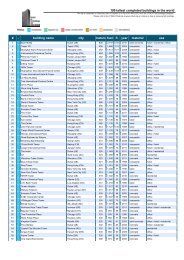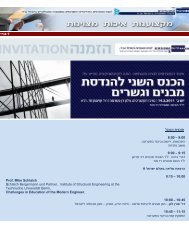צמנט רגיל צמנט : מסמך זה הוא הצעה בלבד מכון התקנים הישראלי
צמנט רגיל צמנט : מסמך זה הוא הצעה בלבד מכון התקנים הישראלי
צמנט רגיל צמנט : מסמך זה הוא הצעה בלבד מכון התקנים הישראלי
You also want an ePaper? Increase the reach of your titles
YUMPU automatically turns print PDFs into web optimized ePapers that Google loves.
ועדה 10601EN 197-1:2011 (E)⎯ the additional requirements to be met by the nationally specified sulfate resisting cements refer to selectedcharacteristics for which the required limit values are more stringent than those for common cements;⎯ having satisfied the local requirements for various cement types many countries apply further restrictions to theproduction of concrete to be used in a sulfate environment, such as minimum cement contents and/or maximumwater/cement ratio that vary depending on the cement type and the type and intensity of the sulfate conditions.Based on the above results common cement types to be harmonized at the European level have been chosen. Thepredominant part of the common cements considered to be sulfate resisting in the market is covered by this selection. Itwas not possible to take into account national particularities the use of which is laid down within national standards,national application rules and regulations/provisions.The strength attained at 28 days is the important criterion in classifying cement for most uses. In order to achieve aspecific strength class at 28 days the early strength, at 2 days or at 7 days, can vary and some types of cement may notattain the minimum early strengths specified in EN 197-1 for common cements.The heat of hydration is linked to the early reactivity and lower early strengths indicate lower heat evolution and lowertemperatures in concrete. For these cements additional precautions in use can be necessary to ensure adequate curingand safety in construction.The purpose of this standard is to specify the composition requirements and conformity requirements for commoncements, including common cements with low heat of hydration and common cements with adequate sulfate resistanceas well as low early strength blast furnace cements and low early strength blast furnace cements with low heat ofhydration.Cement types and strength classes defined in this European Standard allow the specifier and/or the user to fulfilobjectives of sustainability for cement based constructions. Cement types produced by using constituents listed anddefined in Clause 5 allow the manufacturer to minimize the use of natural resources in accordance with local conditionsof production.According to the CEN/CENELEC Internal Regulations, the national standards organizations of the following countriesare bound to implement this European Standard: Austria, Belgium, Bulgaria, Croatia, Cyprus, Czech Republic,Denmark, Estonia, Finland, France, Germany, Greece, Hungary, Iceland, Ireland, Italy, Latvia, Lithuania, Luxembourg,Malta, Netherlands, Norway, Poland, Portugal, Romania, Slovakia, Slovenia, Spain, Sweden, Switzerland and theUnited Kingdom.5
















